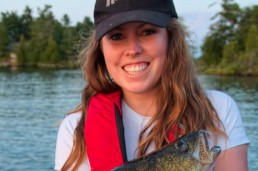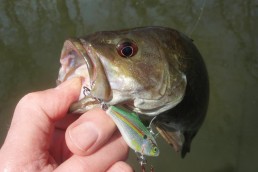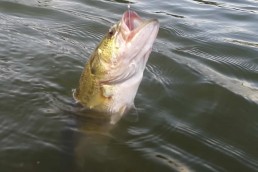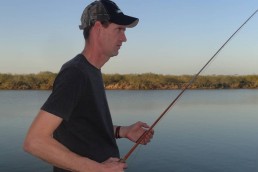Fishing for Smallmouth Bass in Current
SHARE THIS POST
Since moving to Ottawa a couple years ago, I’ve heard so much from local anglers about the fishing opportunities on the St. Lawrence River. This massive body of water flows northeasterly through the bordering waters of Ontario and Quebec, and the United States, covering more than 1,800 miles. It connects the Great Lakes with the Atlantic Ocean. I’ve only been to the St. Lawrence three times so far, but each trip has been memorable and left me wanting more. It’s become a place of awesome catches and you can bet that it’ll be a yearly destination on my calendar.
This past summer, in mid August, I took a trip to the ‘Larry’ over a four-day weekend. The focus was bass, teaming up with my favorite fishing partner, Eric.
Such a large body of water can be overwhelming. Where to begin? We booked in at Ivy Lea Campground and stayed in a lovely camper cabin. It was quite roomy and can accommodate a group of anglers. The prices are great and you can launch a boat right from the campground. Located between Gananoque and Mallorytown, it is a great central spot to explore the fishy country known as the 1000 Islands region.
Windy greeting
We got there on a Friday, during a very windy afternoon. The weather forced us to make the safe decision to wait until the following morning to set out. With three days of fishing ahead, we weren’t disappointed and rigged up our rods, settled into our cabin, and anticipated the next morning. My earliest fishing trips took place at a lodge lined with cabins, so the pine scent sure triggered good memories of childhood. Just like in my youth, I still have the optimism for ‘the big one’ as I drift off to sleep… actually, it keeps me awake most times!
Bass in current
Fishing for bass in current is a whole new ball game in comparison to where I typically spend my days, targeting bass on lakes. Boat control is the key factor in being able to present rigs properly and naturally, as well as adding weight to reach the desired depths for bottom-contact baits. You have to take both current speed and lure weight into consideration, otherwise you will blow by your spot or your baits will get thrown in the current and end up nowhere near the intended position. Thinking ahead by starting a drift beyond where you want to fish and having a great trolling motor (such as my Minn Kota Terrova) will enable you to control your speed and hit the desired locations. What worked well for us was keeping our drift speed down to .8 to 1 mile per hour, by pointing the bow into the current with both Constant and AutoPilot activated on the trolling motor. Without the trolling motor controlling our speed, the current pushed us at about 1.5 to 2 miles per hour. Wind is also a huge factor in speed.
Finding fish
Focusing on offshore main channel humps was how we cracked the code for these smallmouths. We tried fishing around islands, shorelines, and flats but humps were key. Doing several passes on each hump (hitting the front, and drifting down each side) was where we picked up bass although they weren’t holding in great numbers. Stacking and schooling up happens later in the season. A drop-shot rig with a 1/2-ounce weight, or a 1/2-ounce tube jig were our presentations of choice. We ‘matched the hatch’ with similar colors and sizes to gobies which are a main food source in the St. Lawrence River. You can often feel them picking at your bait.
Locating humps with the right depths was crucial for us and we were able to find them using my Humminbird sonar. In the map we saw offshore humps we charted on the Humminbird ONIX SI, using a feature called AutoChart Live. AutoChart Live is an incredible tool which enables you to map water in real time while driving your boat.
Are you enjoying this post?
You can be among the first to get the latest info on where to go, what to use and how to use it!
First, we had a base map of an area showing humps and depth (in feet) without our AutoChart Live on.
The image we saw was the same area after using our AutoChart Live. Think of the colors as warm and cold (warm = shallow, cold = deep). After charting the area, we were able to get more detail and information about the humps. Having this information enabled us to plan our drifts and focus on specific areas which were more likely to hold fish. Fish were primarily holding in the light blue areas (30-35 feet of water) on the sides of the humps. Once we figured this out, we were able to spend our time wisely focusing on specific sections.
Beautiful bonus
One of the weekend highlights for me took place on the first evening. We were almost ready to head back to the cabin and I was dragging a tube jig. It stopped dead and I could not budge it, but it started to move another direction. At first I thought it may be a monster smallmouth but the head shakes were wide. It felt different, and HUGE! After a few moments, I got a glimpse of a big, beautiful walleye and I was not disappointed at all. It was, in fact, my favorite catch of the weekend.
Eric caught the largest smallmouth of the trip on the last day, which was a bittersweet end to another amazing trip on the St. Lawrence. Aside from targeting smallmouths, we ventured out of the main channel and into some back bays and got into a few largemouths and northern pike. There’s no shortage of species to target! I still have muskies on my list, as I haven’t targeted them yet on the St. Lawrence.
This nice largemouth bit my jig first, and I unknowingly thought I was caught up on a reed, fumbled the hookset, then got a tangle in my line. Eric took the opportunity to cast in and steal my fish! At least it was a nice one, and we can chalk it up to “teamwork.”
Needless to say we had an eventful weekend with plenty of catches, some nice quality fish, great weather and a wonderful stay at Ivy Lea Campground. It’s so fun to fish somewhere new and figure out the formula. I can’t wait to head back to the St. Lawrence River again.
MWO
SHARE THIS POST
Did you enjoy this post?
You can be among the first to get the latest info on where to go, what to use and how to use it!
Ashley Rae
Ashley Rae is a Canadian writer residing in Ottawa, Ontario. She is on the water year-round, chasing multiple species. She enjoys sharing her adventures with anglers around the world. You can check in on her latest outings through social media. Find her on her blog at shelovestofish.com.



